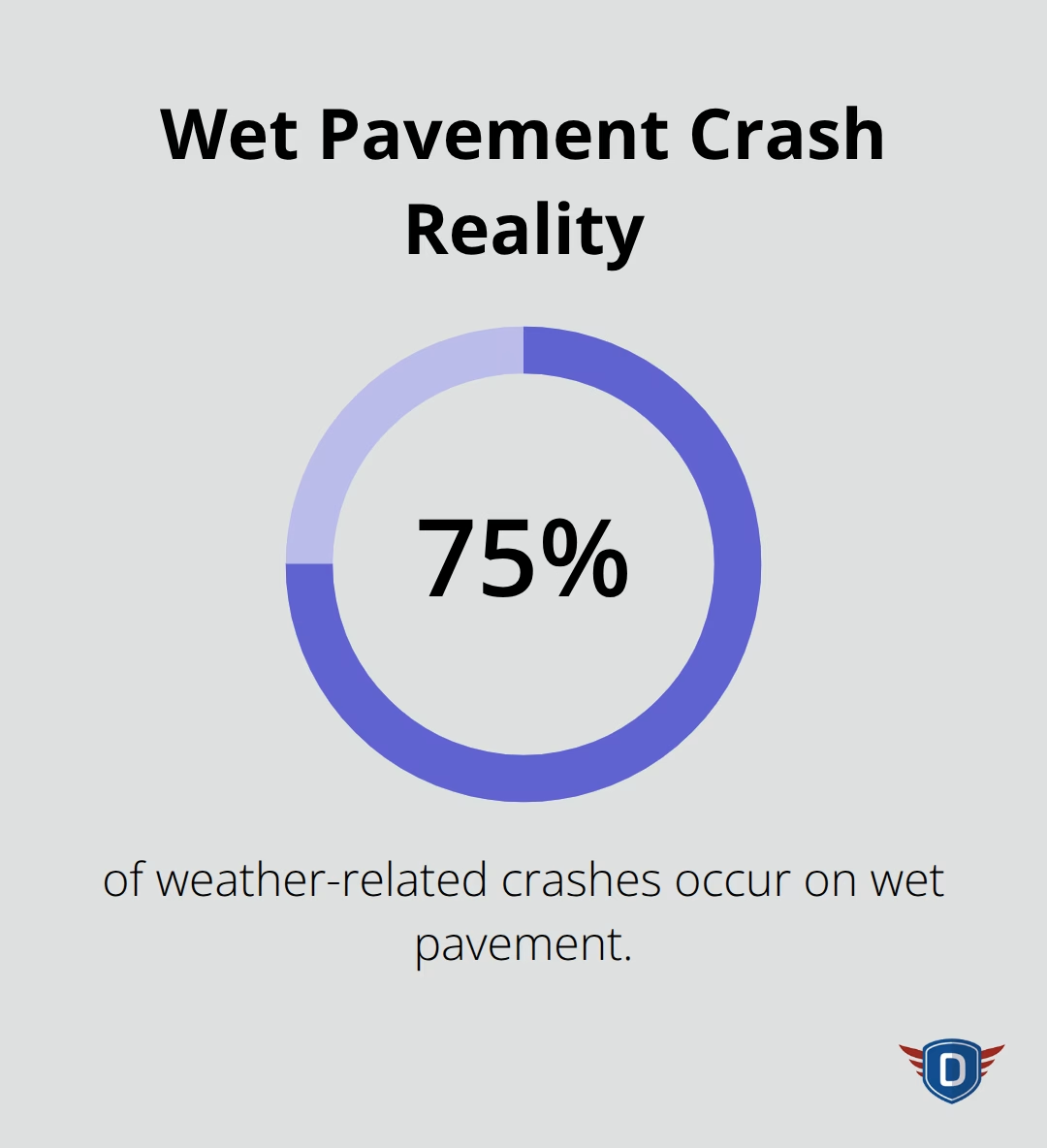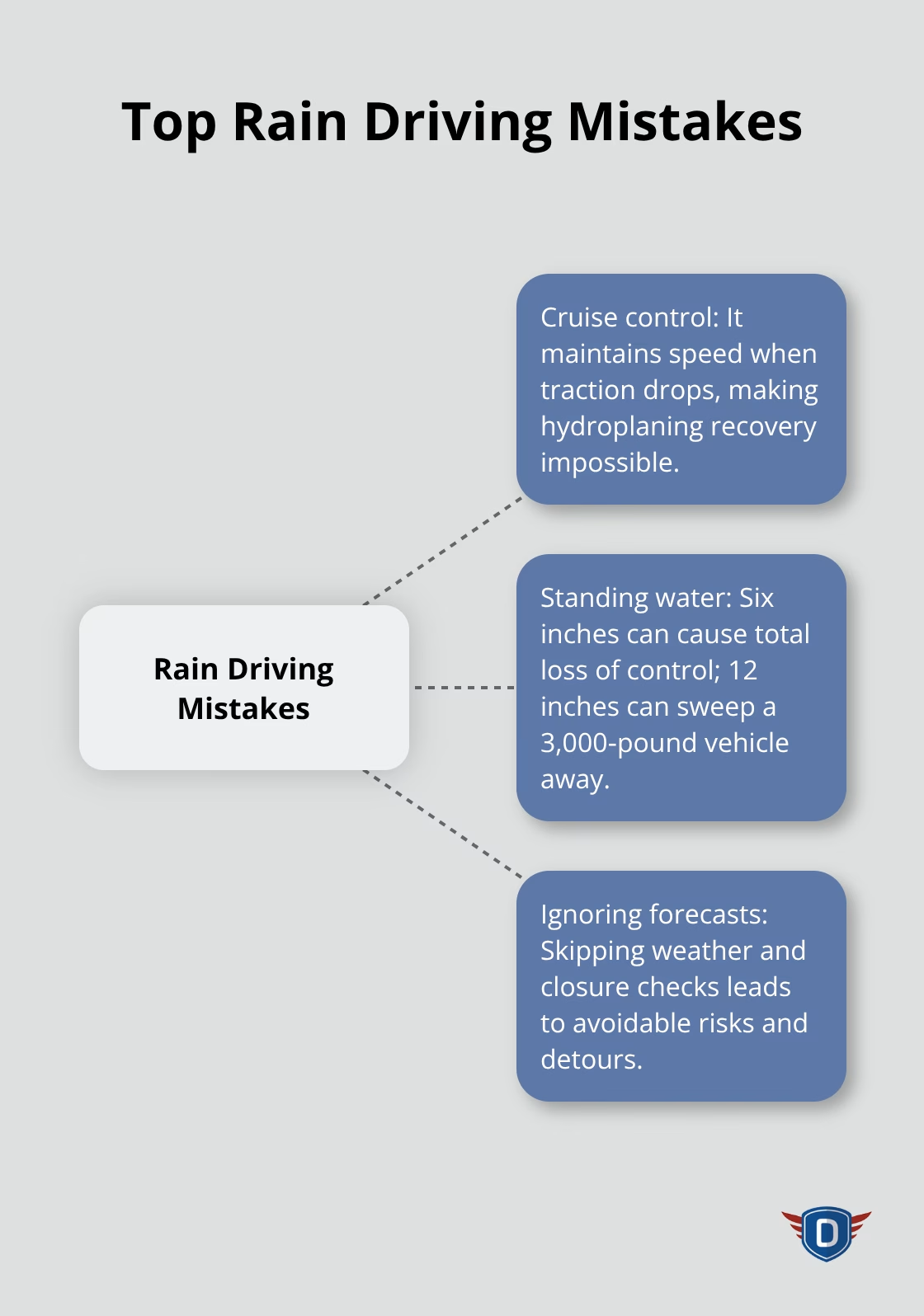Rain transforms familiar roads into hazardous surfaces where accidents spike by 34% according to Federal Highway Administration data. Most drivers lack proper wet weather skills, leading to preventable crashes and hydroplaning incidents.
At DriverEducators.com, we’ve compiled essential driving in the rain safety tips that can save your life. These proven techniques will help you navigate wet conditions with confidence and control.
What Should You Check Before Driving in Rain
Your vehicle preparation determines whether you’ll arrive safely or join the 860,000 annual rain-related accidents that the National Highway Traffic Safety Administration reports. Most drivers skip these simple checks and pay the price when wet roads expose their vehicle’s weaknesses.
Tire Tread Depth Saves Lives
Tires with insufficient tread depth turn your car into a hydroplaning hazard. Use the quarter test: insert a quarter into your tire groove with Washington’s head pointing down. If you can see the top of his head, your tires need immediate replacement. Federal standards require 2/32 inch minimum tread depth, but experts recommend tire replacement at 4/32 inch for wet weather safety. Check tire pressure monthly when tires are cold – properly inflated tires channel water more effectively and reduce hydroplaning risk at speeds above 35 mph.
Windshield Wipers Need Regular Attention
Replace windshield wipers every six months or immediately if they streak, skip, or leave water spots. Clean your windshield thoroughly to remove mineral deposits that create dangerous glare during rain. Test your washer fluid system and clean clogged nozzles with a fine needle. Many drivers ignore these basics until heavy rain hits, then struggle with severely compromised visibility that puts everyone at risk.

Lights Must Function Perfectly
California law requires headlights when you use windshield wipers, and most states have similar requirements. Test all lights (headlights, taillights, brake lights, and turn signals) before any rainy drive. Replace burnt bulbs immediately – other drivers need to see you in reduced visibility conditions. Clean headlight lenses of dirt and oxidation that can reduce light output by up to 40 percent.
Emergency Kit Preparation
Stock your vehicle with essential rain-weather items before storms arrive. Pack a phone charger, flashlight, raincoat, and jumper cables in your emergency kit. Cold, wet weather significantly affects battery performance, with temperature extremes reducing battery capacity by up to 50%. Monitor your battery performance and replace it if you notice hard starts or dim lights.
These preparation steps set the foundation for safe wet-weather travel, but proper technique behind the wheel makes the real difference when rain starts to fall.
How Do You Master Wet Road Driving
Speed reduction becomes your primary weapon against wet road hazards. The Federal Highway Administration confirms that 75% of weather-related crashes occur on wet pavement, with most drivers who maintain dangerous speeds.

Distance and Braking Transform Safety
Triple your following distance from the standard three-second rule to nine seconds on wet roads. Wet pavement doubles stopping distances, and most drivers fail to compensate for this physics reality. The National Highway Traffic Safety Administration reports that inadequate following distance contributes to hundreds of thousands of rear-end collisions annually. Apply brakes gently and progressively – sudden brake pressure locks wheels and eliminates steering control. Modern anti-lock brake systems help, but smooth pressure application prevents dangerous skids before they start.
Smooth Steering Prevents Loss of Control
Make all steering inputs gradual and deliberate on wet surfaces. Sharp turns and sudden lane changes break traction and send vehicles into uncontrollable slides. Turn your steering wheel slowly and maintain steady pressure throughout corners. Avoid abrupt corrections that can trigger dangerous overcorrection cycles (where drivers swing back and forth across lanes). Professional drivers know that gentle inputs maintain tire contact with wet pavement.
Hydroplaning Recovery Saves Lives
When your steering becomes unresponsive and engine noise changes pitch, you’re hydroplaning. Lift your foot off the accelerator immediately – never brake or steer aggressively. Keep your steering wheel straight and wait for tire contact to return, which typically takes two to three seconds. The moment you feel steering response return, gently guide your vehicle back to your intended path. This technique works because fighting hydroplaning with sudden inputs makes recovery impossible and often sends vehicles into dangerous spins across multiple lanes.
These fundamental wet-weather techniques work when drivers apply them consistently, but many common mistakes can instantly negate all your careful preparation and skilled driving.
What Rain Mistakes Put You in Danger
Cruise Control Creates Deadly Traps
Cruise control transforms into a lethal weapon when rain hits the pavement. This system maintains speed automatically when your tires lose traction, making hydroplaning recovery impossible. When hydroplaning begins, cruise control continues to accelerate and maintain the preset speed while you lose all control.
Turn off cruise control the moment rain starts falling. Manual throttle control provides the split-second response you need when tires lose road contact. Professional drivers never activate cruise control in any adverse weather condition because immediate speed reduction saves lives when traction disappears.
Standing Water Kills More Than You Think
Standing water poses extreme danger that most drivers completely underestimate. Just 12 inches of water can sweep a 3,000-pound vehicle off the road, while 6 inches causes total loss of control and floods your engine. The Centers for Disease Control and Prevention report that over half of all flood-related drownings occur when a vehicle is driven into hazardous flood water.

Turn around immediately when you encounter standing water. No destination justifies risking your life for a shortcut through flooded roads. If road markings disappear under water, the depth exceeds safe limits for any vehicle.
Weather Updates Save Lives
Weather forecasts provide advance warning that prevents deadly encounters with dangerous conditions. AAA research shows that 60% of drivers ignore weather forecasts before departure, leading to preventable accidents and dangerous situations. Check weather radar before you leave home and monitor conditions throughout your journey.
Road closure information saves time and prevents dangerous detours through flooded areas that claim vehicles every storm season. Local authorities close roads for legitimate safety reasons (not convenience), and attempting alternate routes through unknown flood zones puts you at extreme risk.
Final Thoughts
Rain transforms ordinary roads into deadly hazards that claim 860,000 vehicles annually. Vehicle maintenance, speed reduction, increased distance, and smooth control inputs prevent most weather-related accidents. These driving in the rain safety tips work when drivers apply them consistently before and during wet conditions.
Practice develops the muscle memory you need when hydroplaning strikes without warning. Most drivers panic during their first loss of traction because they lack proper preparation and technique. Regular wet weather experience teaches you to recognize danger signs and respond correctly when traction disappears.
Professional instruction accelerates your skill development far beyond self-taught methods. We at DriverEducators.com provide expert guidance that transforms nervous drivers into confident operators who handle wet roads safely. Our programs focus on real-world scenarios that prepare you for dangerous conditions (including supervised practice in controlled environments).





